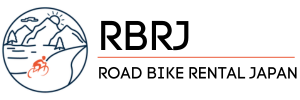
Visión general y guía de Kyoto en bicicleta: Moverse en bicicleta
這本京都自行車指南將概述您需要瞭解的有關京都及其周邊地區騎自行車的所有資訊。
Índice
為什麼要在京都騎自行車
京都有一些令人驚歎的騎行場所。您可以爬山,探索深林,沿著河流踩踏板,穿過風景如畫的城鎮,並在市中心巡遊,尋找鎮上最好的濃縮咖啡。
在自行車上探索時,您不僅會看到A點和B點,還會看到途中計劃外和意想不到的事情。
在我們看來,騎自行車可以讓你看到更多。
隱藏的寶石

城市和主要景點的人群可能非常令人生畏,但幸運的是,京都在市中心和主要旅遊目的地之外潛伏著如此多的自然奇觀和魅力。
騎車進入山區,沿著小街,繞過安靜的郊區,穿過鄉村的農業城鎮,將向您展示日本獨特而真實的一面,這是您堅持走人跡罕至的道路所無法獲得的。
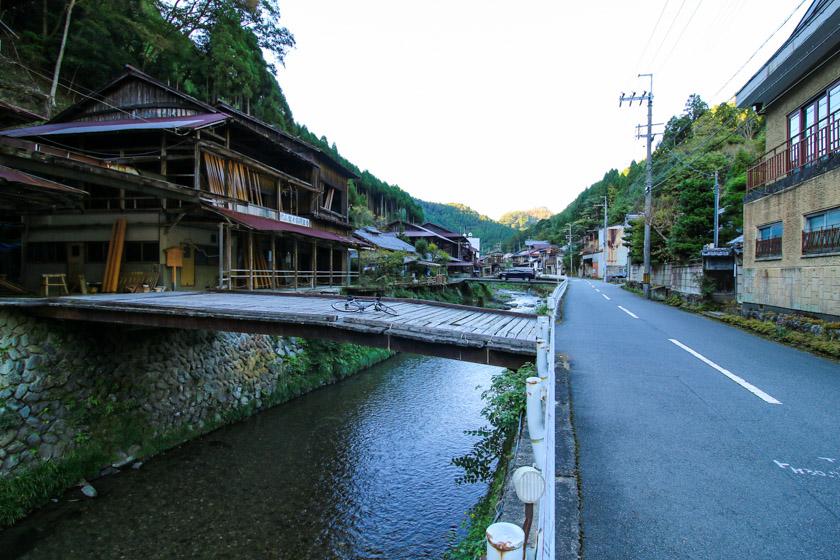
這裡有如此多的神社、寺廟、河流和令人驚歎的原始日本快照,這些都是您在冒險進入農村和偏遠地區時偶然發現的任何指南中都沒有的。
這些時刻是最好的,在日本公路自行車租賃公司,我們的使命是幫助人們在日本期間體驗更多這樣的時刻。
令人驚歎的自然風光

日本真的是一個美麗的國家。然而,有時舉世聞名的文化景點和城市明亮的霓虹燈嗡嗡聲會掩蓋這一點。
這裡有高聳陡峭的山脈,河流和山谷在下方橫掃,具有日本獨有的獨特魅力的鄉村,隱藏在該國角落的神秘的地方神社,似乎將你整個吞噬的廣闊森林,以及讓你在騎行中脫光衣服並跳進去暢遊的海洋和海灘。
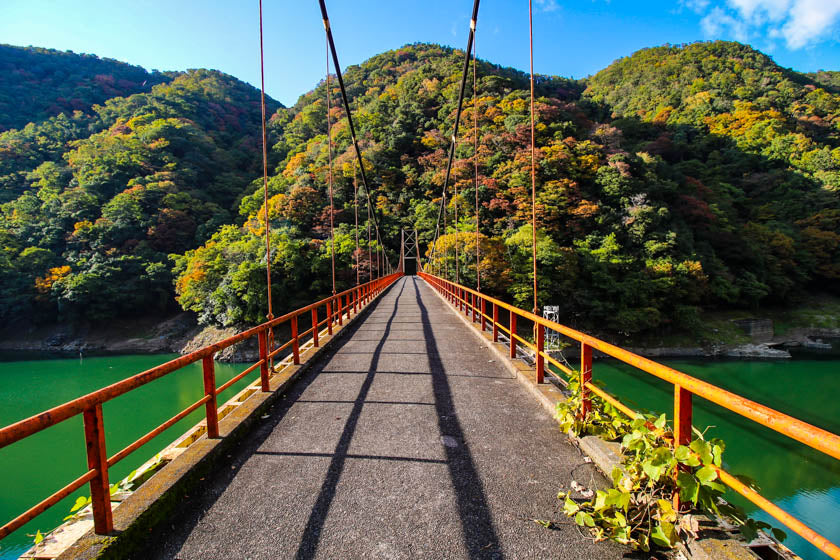
If you catch trains and buses everywhere you can miss a lot of this. However being on a bike gives you the best chance of discovering the real natural beauty of Japan and we’re sure you won’t be disappointed.
速度

自行車比步行更快,因此與四處走動相比,您可以用更少的力氣覆蓋更多的地面。
我們同意,有時在繁忙的地區,最好下車四處走走,但通常自行車會讓你更快地四處走動,而且你可以享受風吹拂你的頭髮。
有趣、健康、環保

騎自行車很有趣。有很多科學解釋試圖解釋為什麼,但當你旋轉這些踏板,讓血液泵送並激起那些內啡肽時,它感覺很好。
鍛煉會讓你心情更好,騎自行車也是平衡你在假期可能做的所有額外飲食的好方法。日本的食物是史詩般的,啤酒在當地餐館自由流動,在旅途中做一些運動可以讓你感覺良好。
騎自行車也使用最少的化石燃料,是一種無污染的交通方式。
氣候變化是世界面臨的最大挑戰,我們相信盡我們所能減少碳排放。
騎自行車作為一種交通方式對環境更有利,我們希望這樣的指南在鼓勵人們騎自行車遊覽京都方面發揮一點作用。
京都佈局
京都位於山谷中,西、北、東四面環山,最高峰愛宕山海拔924米。
Kyoto sits southwest of the largest freshwater lake in Japan, Lake Biwa, however none of the lake actually comes into Kyoto prefecture with the entire body of water sitting in Shiga prefecture.
在本指南中,當我們提到京都時,我們指的是京都市,而不是更大的京都府。
京都市是京都府的首府,約佔縣土地的18%。
When we think about cycling around Kyoto, it’s helpful to break up the city into sections which are listed below:
- 京都西北部
- 京都東北部
- 西京都
- 東京都
- 京都西南部
- 京都東南部
- 京都市中心和市中心
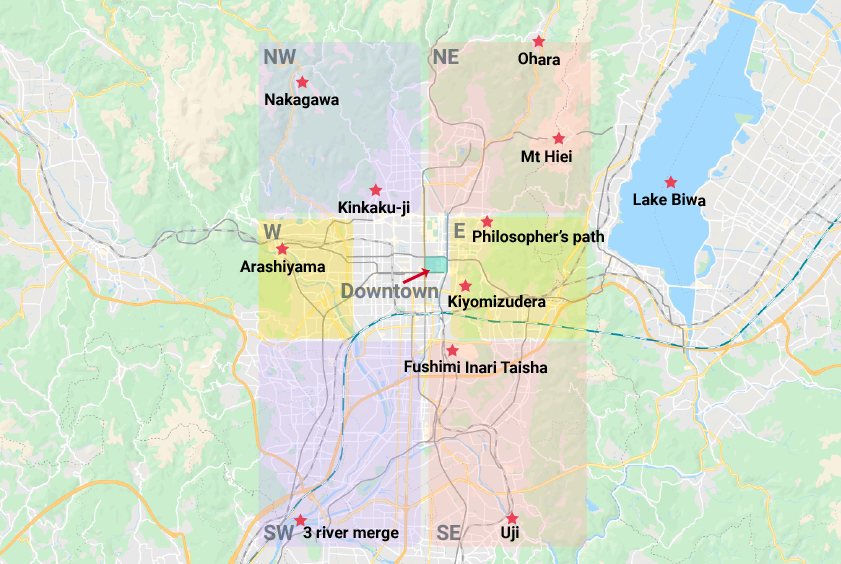
京都市中心和市中心
市中心西與烏丸通接壤,北與禦池通接壤,東與鴨川接壤,南與四條通接壤。
The area is pretty small – 1km squared – making it easy to walk around.
While not everyone follows the rules, cycling on the below streets are prohibited:
- Kawaramachi-dori,位於Oike-dori和Bukkoji-dori之間
- Shijo-dori,位於東大路通和烏丸通之間
- 三條通,介於木屋町通和河原町通之間
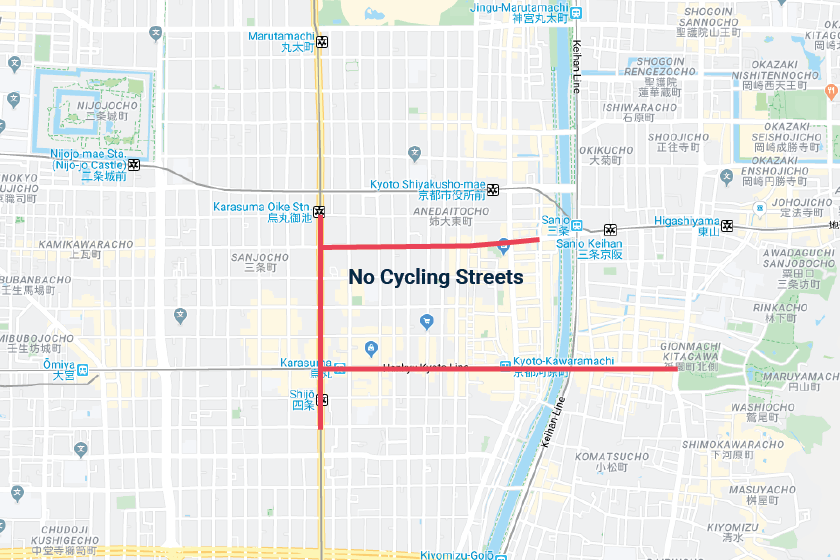
Apart from the prohibited streets (and other streets that are restricted at certain times of the day or during certain events during the year), you can ride around and navigate Kyoto city fairly easily due to the grid layout. It should be noted there is a fair bit of traffic on the roads making peak hours a pretty congested time to cruise the streets.
There are also a lot of traffic lights – especially in the city centre around downtown – making the going pretty slow in some areas.
你還有人流量要應對,這些交通由當地人的日常生活組成,加上每年來京都參觀的大量遊客。

在城市中騎行時,河流是逃避街道交通和污染的有用方式。如果你在市中心或京都東部,你可以沿著鴨川騎行,而如果你在西部,你可以乘坐桂川。
West Kyoto – Katsura river and Arashiyama
西部的桂川是騎自行車開始探索的絕佳起點。
Hay un carril bici a lo largo del río y el paseo tiene momentos preciosos para disfrutar mientras se pedalea.
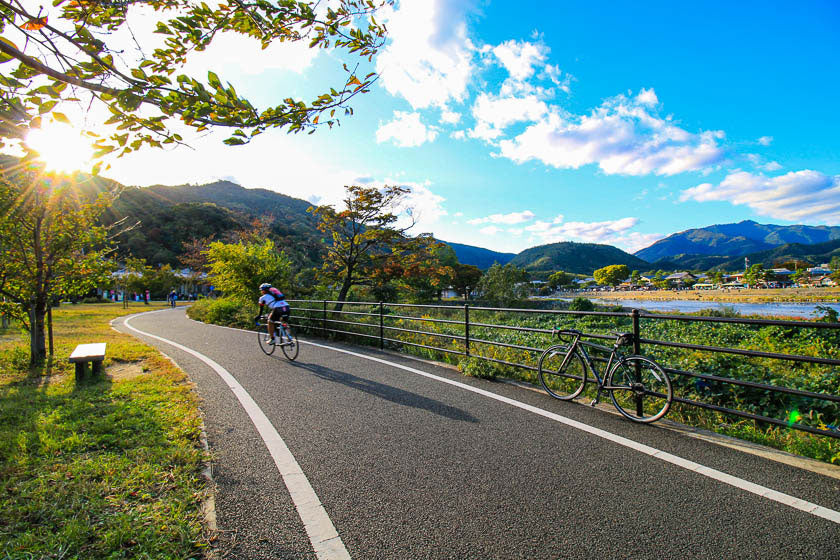
Puede empezar más al sur y dirigirse hacia Arashiyama o empezar en Arashiyama o Matsuo Taisha y dirigirse hacia el sur.
Arashiyama es una parte especial del mundo pero, como otros lugares de Kioto, se llena de turistas. El bosque de bambú, en particular, está muy congestionado, por lo que las primeras horas de la mañana o las últimas de la tarde son el mejor momento para visitarlo.
Una de las mejores partes de pedalear por Arashiyama no es pedalear por Arashiyama en sí, sino por el sendero del río que se dirige hacia el norte en dirección a Arashiyama. Las montañas serpentean por las crestas a medida que la mundialmente famosa zona se va revelando poco a poco en la distancia.
Norte de Kioto
Dividimos el norte de Kioto en secciones noroeste y noreste.
Noroeste - Montañas a Umegahata, Nakagawa y más
Las montañas del norte son impresionantes. Ofrecen subidas, bajadas, pueblecitos de postal y vistas y olores nítidos del bosque y el paisaje.
日本的松樹很漂亮,當你進入山區時,廣闊的森林會讓你感到孤立無援,進入野外。
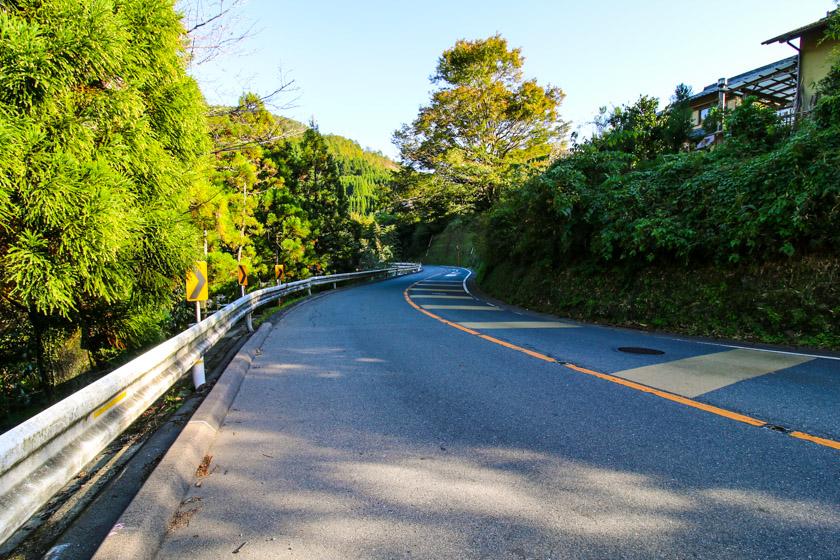
Las montañas del norte son de fácil acceso desde la ciudad, ya que a las rutas del noroeste se suele acceder al norte de Arashiyama y a través de Umegahata.
Northeast – Ohara and Mt Hiei and more
Hay numerosas zonas para recorrer en bicicleta y explorar en el noreste, siendo Ohara un centro neurálgico para muchas de las rutas de la zona.
Ohara es un simple paseo por la 367 justo después del parque del estanque de Takara-ga-ike y la estación de Takaragaike.
Las carreteras de montaña también suben, atraviesan y sobrepasan el monte Hiei, más al este.
El monte Hiei es la segunda montaña más alta de Kioto, y hay algunas subidas importantes si quiere esforzarse y acelerar el corazón.

Si se sube y cruza la montaña se desciende hasta el lago Biwa, también muy popular entre los ciclistas.
東京都
El este de Kioto se considera probablemente la otra orilla del río Kamo y la zona incluye algunos de los lugares más famosos y visitados de Kioto.
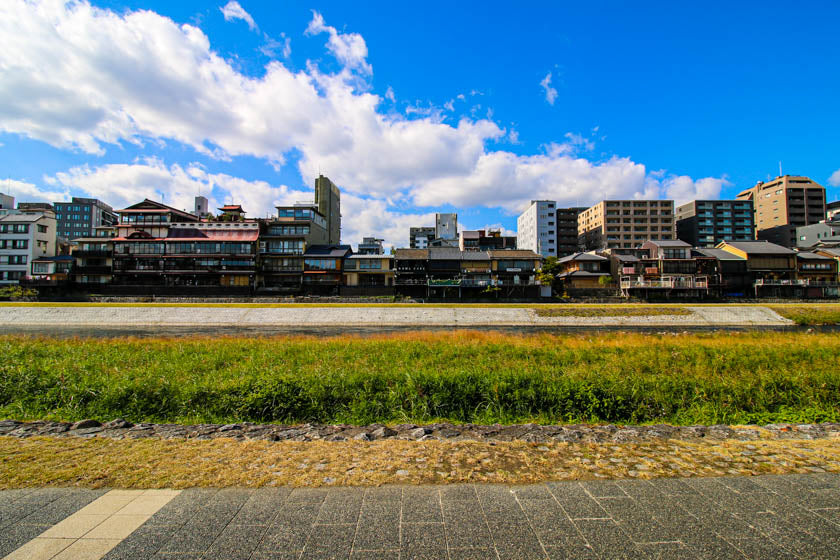
Encontrará el camino del Filósofo directamente al este de la Universidad de Kioto, Nanzen-ji al sur de allí y el templo Kiyomizu dera más al sur de nuevo.
En el este se practica mucho ciclismo, y muchos turistas recorren la encantadora zona de Higashiyama disfrutando de las vistas.
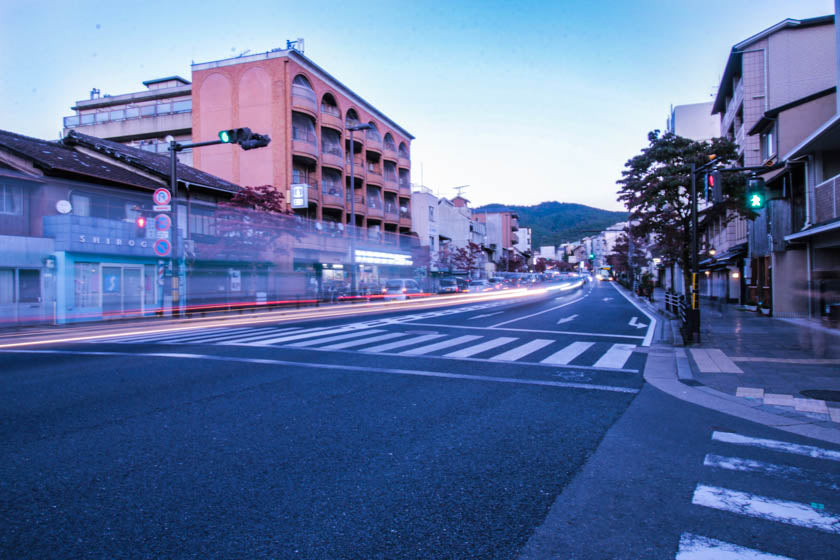
Si lo desea, puede tomar el Sanjo dori colina arriba, pasando por la estación de Keage y por detrás de Kiyomizudera, para acabar en Otsu.
Puede haber mucho tráfico alrededor de la estación de Shinomiya, el intercambiador de Kyoto Higashi y a lo largo de la ruta 1 hasta Otsu, así que evite las horas punta si puede para disfrutar más del viaje.
Sur de Kioto
El sur también se divide en secciones suroeste y sureste.
Sureste - Uji y hacia Nara
Las rutas y zonas del sureste también ofrecen algunas zonas maravillosas para ir en bicicleta. El santuario de Fushimi Inari es un lugar precioso para visitar, pero hay que recorrerlo a pie, así que si quieres visitarlo llega pronto para evitar las aglomeraciones.
El viaje a Uji es una de las rutas obligadas para los ciclistas que deseen disfrutar de un paisaje impresionante.
El trayecto hasta Uji fue bastante bueno, con algunas partes urbanas interesantes pero algunas carreteras con algo de tráfico. Sin embargo, una vez que se llega a Uji y se empieza a remontar el río Uji y luego el Seta, cualquier idea de tráfico desaparece rápidamente.

La carretera que bordea el río es espectacular.
Las sinuosas carreteras son un auténtico placer para la bicicleta, y las espectaculares vistas del río y los puentes a lo largo del recorrido constituyen una fantástica experiencia ciclista.

Para ver la ruta y leer más sobre el recorrido en detalle, consulte nuestra sección Rutas ciclistas de la guía.
El sudeste suele ser el punto de acceso para descender a Nara, un recorrido clásico que no decepciona. La ruta incluye espesos bosques, carreteras ribereñas, granjas, fauna salvaje (ciervos en Nara) y algunas subidas épicas.
También puede encontrar un enlace a un bucle de Kioto a Nara en la sección Rutas ciclistas.
Southwest – Katsura river, three river confluence
El sur de Kioto también es popular entre los ciclistas, ya que suele ser la puerta de entrada de los que se dirigen a Osaka por el río Yodo o a Nara por el río Kizu.
En el sur se encuentra la confluencia de tres ríos: el Katsu, el Uji y el Kizu, que se funden en el Yodo.
Desde allí se puede descender por el río Kizu más al sur hasta Nara, tomar el río Uji hacia el este o saltar al río Yodo y hacer el trayecto hasta Osaka.
Encontrará información detallada sobre las rutas en la sección Rutas ciclistas de la guía.
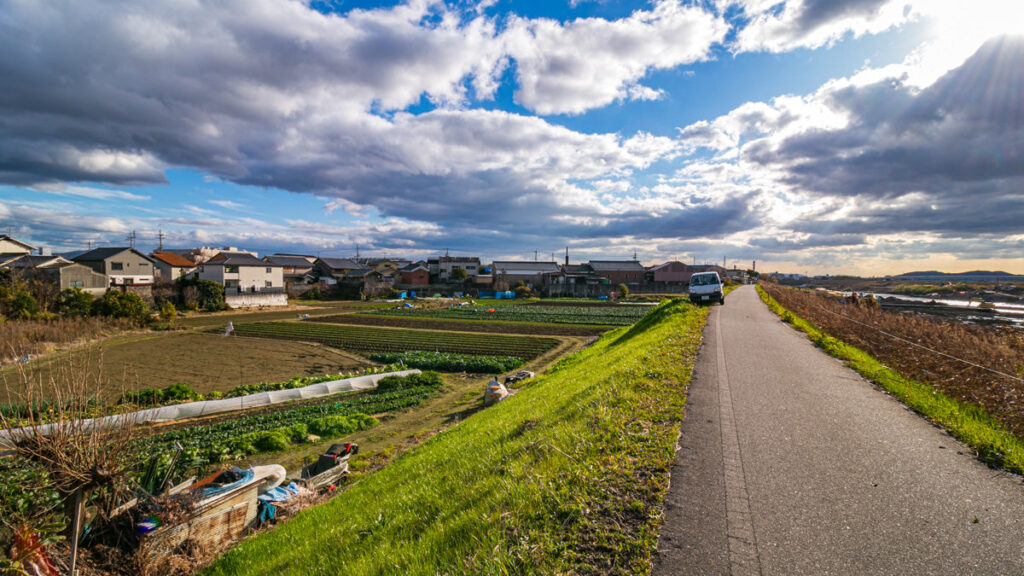
Consejos y normas de circulación
Circular por la izquierda

En Japón se circula por la izquierda. Esta es la regla número uno para los ciclistas que llegan a Japón, porque si vienes de un país en el que se conduce por la derecha, te costará un poco acostumbrarte.
¿Sendero o carretera?

You should always stay to the left of the road unless there is a dedicated cycling path which you should then use. You can actually cycle on the footpaths / sidewalks in Japan pretty freely but there is actually a law stating that you can ride on the footpath if there is a signpost saying it’s possible.
Having said this, you’ll see a lot of people riding on footpaths in Japan so we don’t think you would ever be stopped by police unless you were trying to cycle through the middle of a really busy thoroughfare for pedestrians
Cascos

Recientemente han cambiado las leyes japonesas que obligan a todos los ciclistas a llevar casco. En RBRJ, siempre recomendamos el uso del casco, pero se dará cuenta de que la mayoría de las personas que circulan en bicicleta por las ciudades y los suburbios no lo llevan.
Para que te sientas cómodo, siempre puedes traerte el casco de casa, pero si no es así, la mayoría de las tiendas de alquiler deberían proporcionarte un casco con el alquiler de la bicicleta.
¿Es seguro montar en bici?

En general, Japón me parece un lugar bastante seguro para ir en bicicleta.
Parece haber mucha menos agresividad por parte de los conductores que en Occidente, y los conductores tienden a entender y a tener más en cuenta a los ciclistas. Creo que esto tiene algo que ver con el hecho de que la mayoría de la gente que conduce también va en bici. Puede que no sean ciclistas de carretera, pero probablemente tengan una bicicleta urbana con la que van al supermercado, a la estación de tren o a su barrio.
Por supuesto, todavía hay algunos conductores agresivos en Japón, así que mantén la concentración y peca de defensivo cuando circules entre el tráfico y no tendrás ningún problema.
Alquilar una bicicleta
Alquilar una bicicleta en Kioto es bastante fácil. Hay muchos lugares que alquilan las bicicletas urbanas básicas y las tarifas diarias no son tan caras.
Los hoteles también tienen a veces un servicio de alquiler de bicicletas para los huéspedes, así que consulte con su alojamiento, ya que es posible que el alquiler de bicicletas esté incluido en la habitación.
La bicicleta básica que transporta a la mayoría de la población local en su día a día se llama Mamma-chari. Se trata de una bicicleta de una sola velocidad con una cesta en la parte delantera.
Si desea una bicicleta con algunas marchas, existen varias opciones, muchas de ellas con manillar plano.
En el caso de las motos de carretera y deportivas, la oferta es mucho más limitada.
En RBRJ, estamos especializados en motos de carretera y de paseo de alto rendimiento y también disponemos de una sólida gama de motos de paseo.
Para ver la gama de bicicletas de carretera y de paseo, consulte el siguiente enlace:
Gama de bicicletas de carretera y de paseo >
Rutas ciclistas
Hay muchas zonas diferentes por las que puede pasear en bicicleta en Kioto. Desde acercarse a la ciudad y los suburbios hasta salir de la ciudad y encontrar algunos bosques aislados y tranquilos pueblos rurales.
Para que te hagas una idea general de por dónde circulan los ciclistas en Kioto, echa un vistazo al siguiente mapa de calor de Strava: las líneas rojas indican la actividad ciclista.
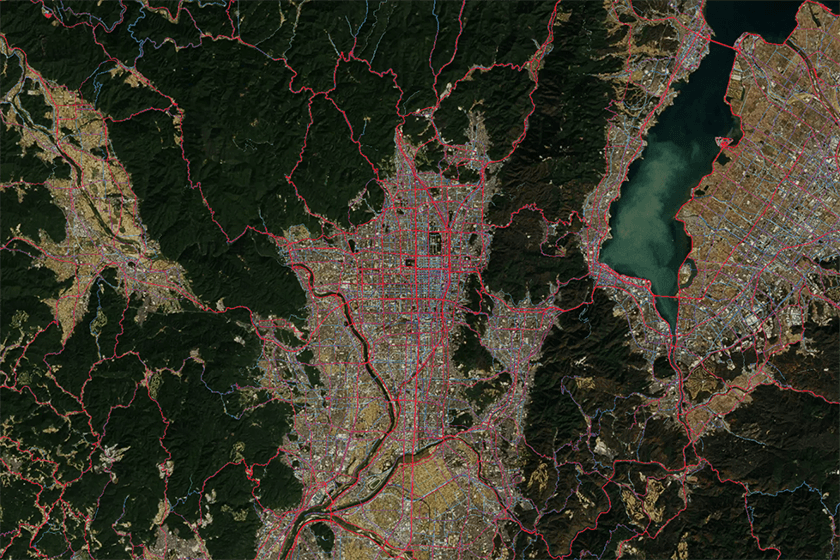
A continuación se muestran algunas rutas ciclistas de ejemplo que se dividen en:
- Rutas más cortas
- Rutas de longitud media
- Rutas más largas
Rutas más cortas
De Sanjo al Camino del Filósofo
Distancia: 4,6 km
Ganancia de elevación: 84m
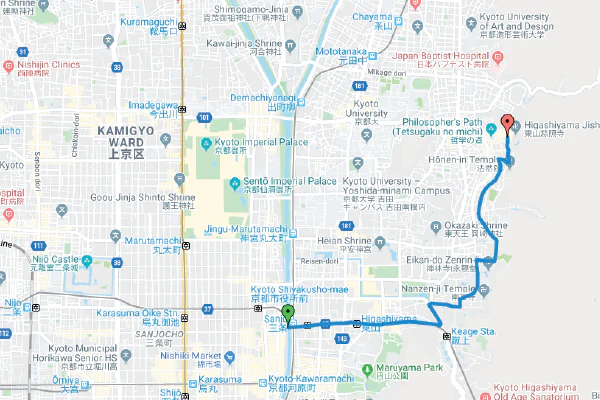
嵐山到三河匯合處
Distancia: 20km
Elevación: 93m

中長路線
Northeast and Northern loop – Ohara and Kamo
Distance: 40.27km
Elevación: 474m
View route on Google maps >

Northwest mountains ride – Umegahata, Nakagawa
Distancia: 58km
Ganancia de elevación: 865m
View route on Google maps >
Link to route guide and blog

Kyoto to Osaka – Katsura and Yodo rivers
Distancia: 49km
Elevación: 308m
Link to route guide and blog >

更長的路線
Kyoto to Uji to Otsu loop – return to Kyoto city
Distancia: 70km
Ganancia de elevación: 903m
Link to route guide and blog >

京都和琵琶湖環線
Distancia: 218km
Elevación: 1,184m
Link to route guide and blog >

自行車停放處
Considering the amount of people that ride bikes in Kyoto the bike parking isn’t particularly good.
A la hora de aparcar su bicicleta en Kioto, tiene prácticamente las siguientes opciones:
- 免費名額
- 付費景點
- 您應該始終避免的景點
免費名額
在不太繁忙的地區,自行車通常可以免費停放在人行道和道路上,沒有任何問題。例如,如果您在餐廳停下來吃午飯,您通常可以把自行車停在前面,而您吃飯時不必擔心。
餐廳或購物中心甚至可能為顧客提供自行車停車場。
這裡的一個關鍵點是,您可以在有限的時間內停放自行車。如果你去便利店,買幾件東西,然後很快回到你的自行車上,你可能會沒事的。
但是,如果您將自行車放置數小時或更糟的數天,您的自行車被從看似安全和自由的地方拿走的機會就會增加。
付費景點
在城市中,您會發現上鎖的停車位,您大部分時間都可以自由使用。您只需將車輪轉入,等待它鎖定,然後就可以出發了。當你回來時,你在機器上輸入你的自行車停放號碼,並支付小額費用,通常是100或200日元。
一些自行車停放點主要面向按月或按年付費的車主,但其中一些地方也接受每日停車,但收取少量費用。
禁止停車
However, in busier parts of the city there are places where you shouldn’t park your bike, even for a few minutes. Places such as outside of main train stations, department stores, office buildings in the CBD and high-end shops are pretty regulated and you will find you will get a warning tag quickly followed by your bike taken if you don’t move it ASAP.
如果您的自行車被城市自行車清掃帶走,請檢查地面上是否有一張紙,它會告訴您自行車被帶到哪裡。如果你帶著自行車鑰匙去那裡,你可以付費拿回你的自行車。
我們通常建議謹慎停車,特別是如果您有更昂貴的自行車。如果您的酒店附近有付費停車位,最好使用它並使用您的自行車鎖。
值得詢問您的酒店是否可以將您的自行車存放在裡面,或者他們是否有自行車停車場。有些酒店會這樣做,但很多酒店會要求您在外面找到自行車停車位,所以如果是這種情況,請詢問他們附近是否有付費自行車停車場。
對騎自行車的人有用
以下是一些有用的資訊,或者在京都騎自行車時可能會派上用場。
購買裝備或維修的商店

Y's Road Kyoto(京都Y's Road酒店)
Y’s road Kyoto has a great range of bikes and parts and the staff are also pretty knowledgeable too. There is basic English assistance (depending on the staff member) and if you need repairs they are reliable and also not that expensive. Shop location here >
To be honest, the website is a bit of a mess and could really be improved a lot. Your best bet is to visit the store and have a look at the range and speak to staff if you need.
騎自行車的最佳季節

在京都騎自行車的最佳季節是春季和秋季。仍然可以在夏季和冬季騎自行車,但要注意夏季的極端高溫和潮濕,還要注意冬季的零度以下溫度,這會給道路帶來積雪和危險的結冰條件。
春天
春天的天氣很美,如果幸運的話,您甚至可以在騎行時捕捉到一些櫻花。
三月可能仍然有點冷,但我們發現三月、四月和五月非常適合騎自行車。5 月比 3 月溫暖一些,但請記住,櫻花季節也會帶來人群,所以一定要儘早預訂,如果可以的話,也許可以避開高峰景點。前往一些鄉村或山區騎行,您可能會在鄉村周圍看到令人驚歎的櫻花,這會讓您停下來欣賞美景。
See the below link for the temperatures in Kyoto in April 2023 >
秋天 / 秋天
秋天也非常適合騎自行車,在RBRJ,它可能是我們的最愛。秋天的色彩非常壯觀,它們也比櫻花持續的時間更長,這意味著您有更好的機會捕捉到不斷變化的顏色的美麗。
就騎自行車的好天氣而言,這個季節可能比春天持續的時間要長一些。9 月初仍然很熱,但它開始降溫,從 9 月中旬到 12 月,日本是騎自行車的黃金地段。
See the below link for the temperatures in Kyoto in October 2023 >
Verano
你也可以在夏天騎自行車,但如果你真的感覺到炎熱,夏天對你來說可能太多了。濕度加上熱量可以在陽光下度過炎熱的日子。如果您確實騎自行車,請小心並確保休息並喝足夠的水。
See the below link for the temperatures in Kyoto in July 2023 >
Invierno
冬天也可以產生一些可愛的騎自行車的日子,就在前幾天,我們在 13 度的陽光下騎車,我們都認為這是理想的騎自行車天氣。然而,天氣可能會變得非常寒冷,如果你沒有合適的裝備,你會很快感到非常不舒服。
更不用說下雪和結冰的機會了,所以在路上要小心,並盡量提前檢查天氣以計劃你的日子。
當然,海拔越高,道路上就越有可能有雪和非常危險的冰,所以如果你要進山,要好好注意道路上的冰雪。
See the below link for the temperatures in Kyoto in January 2023 >
自行車運輸

If you want to take your bike on the train you can, however you need to cover it completely. To see our full blog post on taking your bike on the train in Japan please see the below link on our Osaka site:
Taking bikes on trains in Japan – guide and instructions on using a train bag >
第三方保險

In more and more prefectures across Japan third party property and person insurance is becoming mandatory for cyclists. Not only for local cyclists but also for visitors from overseas.
If you rent a bike check with the rental shop that the bike has third party insurance and if they don’t, we advise you find a place that does.
If you are bringing your bike from home you also need to insure yourself which can be tricky as it’s usually done in Japanese. 7/11 offers a pay as you go insurance and you can buy it from their kiosks in-store.
Ask the staff if they can help you get the insurance and hopefully you’ll get some English assistance.
All RBRJ bike rentals are covered for third-party property and person. You can find more details about the insurance from the below link:
緊急聯繫人

While in Kyoto and especially if you are cycling there is a chance that you might need medical services at a stage. While Japan is a very safe country and cycling here is also pretty safe, it’s good to prepare in case of an accident or injury.
需要注意的幾點是:
- 瞭解您當地的醫院或診所
- 確保您有旅行保險來支付醫療費用
- Don’t assume the hospital is open late at night or on weekends
- 撥打 119 報警和救護車
- 撥打 110 報警
瞭解您當地的醫院
Firstly, it’s good to check where your local hospital is.
If you have a more severe medical problem a larger hospital is better, however for common colds and less serious problems you can see a Doctor at a local clinic who will refer you to a hospital if they think it’s necessary.
旅遊保險
Make sure you come with travel insurance, especially if you plan on doing any cycling. Health care in Japan is excellent and also very affordable, however if you don’t have any insurance you’ll pay 100% and if it’s complicated treatment it can get very expensive.
Don’t assume hospital is open
一些醫院和診所在深夜和周末關閉。在去醫院之前,先在谷歌上檢查醫院是否開放。
緊急電話號碼
在日本,救護車和消防以及員警有一個單獨的號碼。救護車或消防電話請撥打 119,員警請撥打 110。
通常電話裡有英語説明,但盡量放鬆,慢慢說話,以幫助接線員瞭解您的情況。
- 119 para bomberos y ambulancias
- 110 para la policía
Reflexiones finales
我們認為騎自行車是遊覽京都的最佳方式,如果您決定在古都騎自行車,我們希望本指南中的資訊對您有所説明。
This guide will periodically be updated with new information for cyclists so if you have any ideas or useful links that we’ve missed, let us know in the comments and we’ll try and include them.
享受在京都騎自行車的時光,如果您有任何問題,請隨時與我們聯繫!
